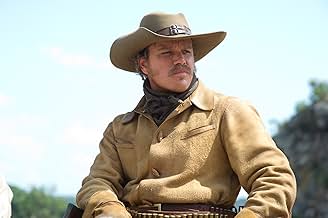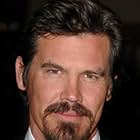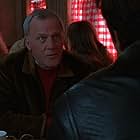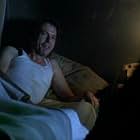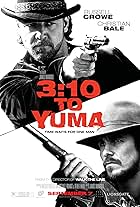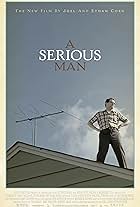A stubborn teenager enlists the help of a tough U.S. Marshal to track down her father's murderer.A stubborn teenager enlists the help of a tough U.S. Marshal to track down her father's murderer.A stubborn teenager enlists the help of a tough U.S. Marshal to track down her father's murderer.
- Nominated for 10 Oscars
- 38 wins & 169 nominations total
- Directors
- Writers
- All cast & crew
- Production, box office & more at IMDbPro
Storyline
Did you know
- TriviaBecause of child labor laws, Joel Coen and Ethan Coen were unable to film any scenes past midnight with Hailee Steinfeld (especially difficult because the movie contains many night scenes), and because of scheduling problems, any time there is a shot of another character over Mattie's shoulder or back, Mattie is played by an adult double, not Steinfeld.
- GoofsMattie and her horse are completely dry right after swimming across the river. This same error occurs in the original film.
- Quotes
LaBoeuf: As I understand it, Chaney... or Chelmsford, as he called himshelf in Texas... shot the senator's dog. When the senator remonstrated, Chelmsford shot him as well. You could argue that the shooting of the dog was merely an instance of malum prohibitum, but the shooting of a senator is indubitably an instance of malum in se.
Rooster Cogburn: Malla-men what?
Mattie Ross: Malum in se. The distinction is between an act that is wrong in itself, and an act that is wrong only according to our laws and mores. It is Latin.
Rooster Cogburn: I am struck that LaBoeuf is shot, trampled, and nearly severs his tongue, and not only does not cease to talk, but spills the banks of English!
- Crazy creditsBuster Coen, Ethan Coen's son, is listed in the end credits as "Mr. Damon's abs double". In reality, he was an on-set assistant to the script supervisor.
- ConnectionsFeatured in The Tonight Show with Jay Leno: Episode #19.51 (2010)
- SoundtracksLeaning on the Everlasting Arms
Written by Elisha A. Hoffman and Anthony J. Showalter
The Hathaway version, while tampering with details from the Portis original, remains strikingly true to its story and theme. This is most clear in the dialog - the decision not to tamper with Portis' language was decisive for the making of that film. The Coens' tampering with the novel is more subtle than Hathaway's film, but no less an interpretation.
Approaching the characters and composition of the Coens' version without reference to the Hathaway film apparently proved impossible. For instance, the shoot-out at the dug-out cabin was re-written for a night-scene, but the camera angles remain pretty much the high-elevation shots Lucien Ballard provided Hathaway, inter-cut with full body shots of people getting wounded and horses running (etc.)also similar to Ballard's.
Two performance stand out as striking examples of reference to the original film. Dakin Matthews seems to struggle mightily not to recreate Strother Martin's interpretation of the horse-trader Stonehill - and fails. Apparently Martin had the character down pat and there's nothing but to reproduce his interpretation. Far more to the point is Barry Pepper's interpretation of the desperate outlaw chief, Ned Pepper - it is pure Robert Duvall. Pepper can only match Duvall's self-aware determination - and he does - but he can't surpass it; nor can he find another interpretation to set off against Duvall's.
As for the Coens' own re-interpretation of the Portis novel, what was most noticeable to me were the minor points simply dropped out of the story telling. The most irritating to me were a pair of lapses that are interconnected and combine to make an important point about the characters. 1. We never get to see Mattie tell Rooster that Chaney has linked up with Ned Pepper (later Rooster does remark the fact, but how did he learn of it?); 2 We don't get to hear Rooster's remarking how he shot Pepper through the upper lip (because he was aiming at the lower lip). These two incidents combine to let the audience know that Cogburn's hidden agenda on the Chaney hunt is really Ned Pepper, he and Pepper have something of a feud going on - which information fills out the background detail for their final shoot-out. Except here we don't have that connection.
Finally, the whole Mattie - Rooster issue: many critics are saying that Mattie is more at the center here than in the Hathaway picture, which focused attention on John Wayne's Cogburn. Not true. When we add up screen time and lines of dialog, we discover that Mattie not only has as much time and dialog in the Hathaway film but it is in much the same proportion to Cogburn's as in this one. If most remember the Hathaway film as a 'John Wayne film,' that is due simply to Wayne's bravura performance.
Well, enough of the comparisons. Does the Coens' version measure up as film worth seeing on its own accord? Yes; we are presented here with a beautiful, frightening, amusing piece of 'Americana.' There are scenes approaching dream-like states, as in the meeting with the bear-man, and during Rooster's desperate drive to get Mattie to a doctor. Hailee Steinfeld is quite engaging, and Matt Damon develops an intriguing complexity that makes one wish he had more screen-time. Bridges' performance is the most problematic - Bridges plays Cogburn as a a kind of whimsical brute - as he rambles on with his life-story on the trail, we get the gnawing sense that, if we were not along for a dangerous manhunt and dependent on his abilities as a master man-hunter, Cogburn would be someone we would not like to know. This develops a distance between the audience and Cogburn that is actually rather on par for the Coens - there are no 'heros' in the Coen universe.
Perhaps that's a good thing here. Mattie in her experiences with the wild men of the old west has encountered something larger than her life on the farm could ever get her. These are men who make their own laws and are not bound to statutory codes or biblical decrees, and adapt their own law to the wilds of the frontier that surrounds them. Mattie is a confirmed church-goer with a good lawyer, and if she weren't so determined on her revenge, she would actually be impossibly small-minded and dull. This is a subtext to the novel that both films attempt to convey, but neither quite captures, because it's difficult for any film maker to admit that the central character of the story is the least interesting.
The age of such wild-men has passed. It is not that wild-men do not exist - wild-men show up quite frequently in Coen Brothers' films in contemporary settings - but now they are corrupted by moving outside the law and outside the commonplace, they grow sick and psychopathic. The killer in "Fargo" feeding the partner he's killed to a wood-chipper is as wild as one could get, but he is no longer larger than life, and evokes only the sickness at the heart of modernity, not any adaptation one would want to live with.
We look back at historical moments like those of the Old West because anything seemed possible to them, whereas very little is possible for us. But that might simply be a wishful delusion - and the Coens' clear suspicion that it is really determines the limits of what they accomplish here. They don't present the West as 'it really was,' nor do they present what we want from it, rather they present a disappointment with it. Rooster Cogburn is indeed 'larger than life,' but we wouldn't want to spend any more time with him than we do.
Details
- Release date
- Country of origin
- Official site
- Language
- Also known as
- Temple de acero
- Filming locations
- Production companies
- See more company credits at IMDbPro
Box office
- Budget
- $38,000,000 (estimated)
- Gross US & Canada
- $171,243,005
- Opening weekend US & Canada
- $24,830,443
- Dec 26, 2010
- Gross worldwide
- $252,278,285
- Runtime1 hour 50 minutes
- Color
- Sound mix
- Aspect ratio
- 2.39 : 1







